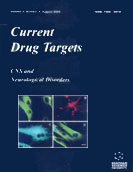Abstract
Metabotropic glutamate receptors (mGlu) are GTP-binding (G) protein-coupled receptors (GPCRs) that are involved in learning and memory, cardiovascular control and motor function. Their structure and pharmacology has been reviewed recently in Current Drug Targets: CNS and Neurological Disorders (Vol. 1, Issue 3) where their roles in a variety of neurological disorders were highlighted. The present review focuses on the emerging evidence for interactions of mGlu receptors with other GPCRs in the CNS at the membrane interface and amongst signaling cascades in the cytosol (e.g. intracellular Ca2+, cAMP and scaffolding proteins). While initially non-selective activity was thought to be responsible for many atypical responses, increasing evidence points to GPCR interactions in neurons and glia, with adrenoceptors, adenosine receptors, dopamine receptors and muscarinic receptors. For example, group II mGlu receptors were found to be required for group I mGlu receptor induction of long-term potentiation at the postsynaptic terminal. Increasing evidence demonstrates the intimate interaction of adenosine receptors and mGlu receptors, particularly in the regulation of neurotransmitter release. While adenosine itself can be released from astrocytes by co-activation of group II mGlu and β-adrenergic receptors. Given the complexity of neurological disorders such as ischemic stroke, Alzheimers disease and epilepsy, exploitation mGlu receptor-associated GPCR interactions may prove efficacious in the treatment of such disorders.
Keywords: metabotropic glutamate receptor, g proteins, g protein-coupled receptors, adenosine, dopamine, adrenoceptors, neurons, glia, camp, intracellular
 3
3

















